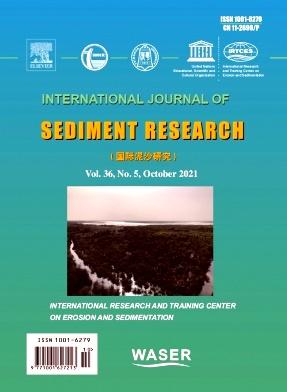Contributions of flow discharge, slope gradient, and scouring time on rill erosion: A quantitative study of exposed slopes in the loess region
IF 3.5
2区 环境科学与生态学
Q2 ENVIRONMENTAL SCIENCES
引用次数: 0
Abstract
Flow discharge, slope gradient, and erosion time are widely recognized as crucial factors in determining rill erosion and its morphological characteristics. However, the relative importance of these three factors needs to be further elaborated to refine the understanding of rill erosion. In the current study, scour experiments were done under various conditions, including five flow discharges (0.5, 1.0, 1.5, 2.0, and 2.5 mm/min), five slope gradients (5°, 10°, 15°, 20°, and 25°), and durations of 20, 40, and 60 min. The resulting rill erosion process and its related morphological characteristics have been documented and analyzed. The results demonstrate that the average soil loss rate increased significantly with the increase inflow discharge and slope gradient. The individual effect of flow discharge (38.35%) was more pronounced than that of slope gradient (18.38%). Increasing flow discharge, slope gradient, and scouring time intensified the occurrence of headward erosion. Over extended erosion durations, rill length, width, depth, and volume all experienced increases. Additionally, with higher flow discharge and steeper slope gradient, the rill width-depth ratio decreased, indicating that rills became narrower and deeper. The individual effect of flow discharge on all rill morphological characteristics was more pronounced than that of slope gradient and scouring time. Except for rill length, the slope gradient had a greater impact on rill morphological characteristics than scouring time. Importantly, a significant portion of the runoff's potential energy was channeled into soil erosion rather than kinetic energy in sediment-laden flow. Based on the principle of energy conservation, the occurrence of rills reduced the energy required for soil erosion from 83.84 to 598.96 J/kg to 2.22–37.53 J/kg. The current study deepens the understanding of rill erosion mechanisms on the Loess Plateau in China and provides a scientific foundation for soil erosion control.
流量、坡度和冲刷时间对细沟侵蚀的影响:黄土地区露坡的定量研究
径流量、坡度和侵蚀时间被广泛认为是决定细沟侵蚀及其形态特征的关键因素。然而,这三个因素的相对重要性需要进一步阐述,以完善对细沟侵蚀的认识。在本研究中,在不同条件下进行了冲刷实验,包括五种流量(0.5,1.0,1.5,2.0和2.5 mm/min),五种坡度(5°,10°,15°,20°和25°),持续时间为20,40和60 min。由此产生的细沟侵蚀过程及其相关形态特征已被记录和分析。结果表明,随着入流流量和坡度的增加,平均土壤流失率显著增加。流量的个体效应(38.35%)大于坡度的个体效应(18.38%)。径流量、坡度和冲刷时间的增加加剧了向坡侵蚀的发生。随着侵蚀持续时间的延长,细沟的长度、宽度、深度和体积都有所增加。随着流量增大和坡度增大,细沟宽深比减小,细沟变窄、变深。流量对细沟形态特征的个别影响比坡度和冲刷时间的影响更为显著。除细沟长度外,坡度对细沟形态特征的影响大于冲刷时间。重要的是,很大一部分径流的势能被转化为土壤侵蚀,而不是泥沙流的动能。基于能量守恒原理,细沟的发生使土壤侵蚀所需能量从83.84 ~ 598.96 J/kg降低到2.22 ~ 37.53 J/kg。本研究加深了对黄土高原细沟侵蚀机理的认识,为土壤侵蚀治理提供了科学依据。
本文章由计算机程序翻译,如有差异,请以英文原文为准。
求助全文
约1分钟内获得全文
求助全文
来源期刊
CiteScore
6.90
自引率
5.60%
发文量
88
审稿时长
74 days
期刊介绍:
International Journal of Sediment Research, the Official Journal of The International Research and Training Center on Erosion and Sedimentation and The World Association for Sedimentation and Erosion Research, publishes scientific and technical papers on all aspects of erosion and sedimentation interpreted in its widest sense.
The subject matter is to include not only the mechanics of sediment transport and fluvial processes, but also what is related to geography, geomorphology, soil erosion, watershed management, sedimentology, environmental and ecological impacts of sedimentation, social and economical effects of sedimentation and its assessment, etc. Special attention is paid to engineering problems related to sedimentation and erosion.

 求助内容:
求助内容: 应助结果提醒方式:
应助结果提醒方式:


